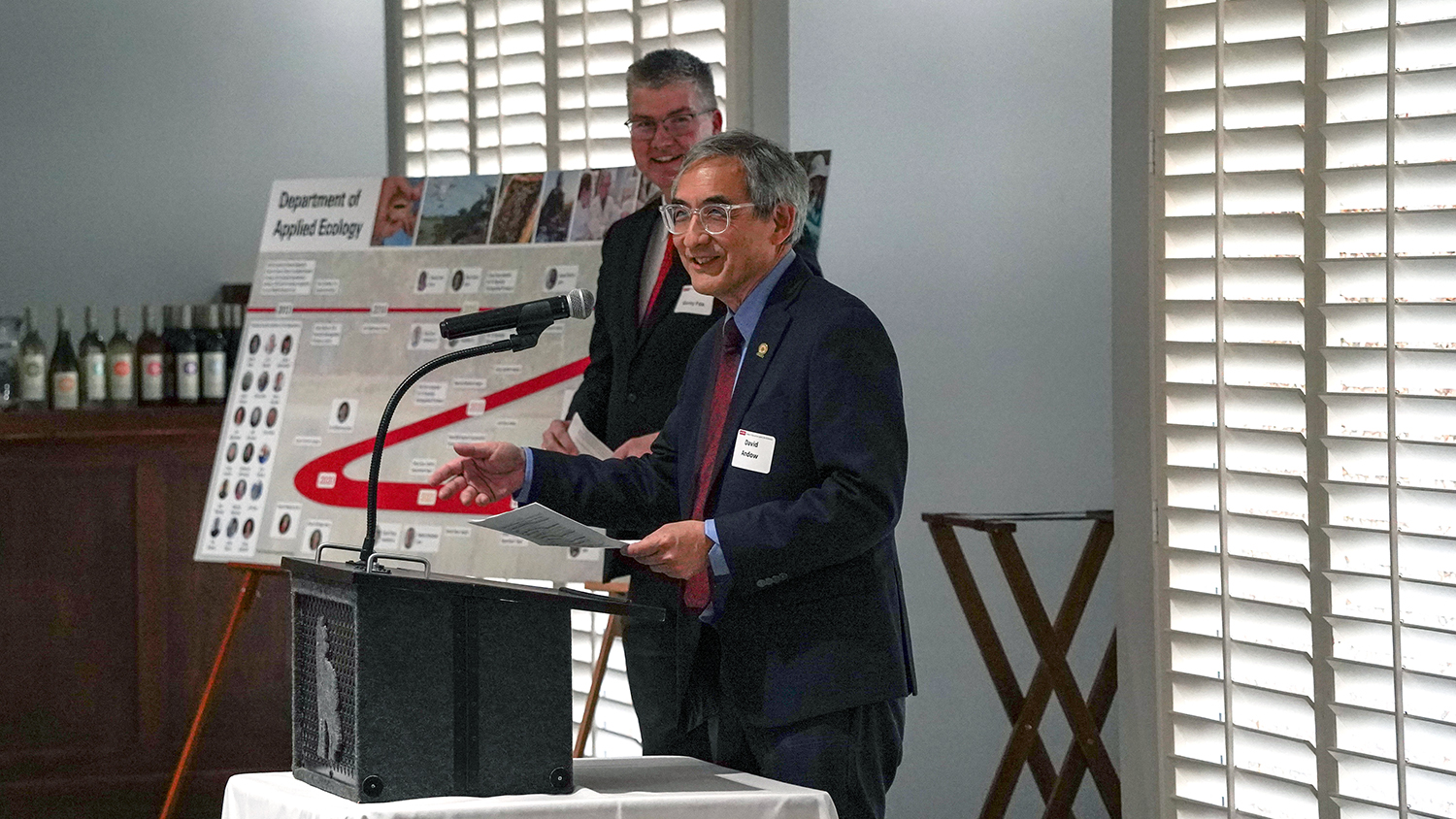Making the methane conversion process value-added and eco-friendly
Gourishankar Karoshi, a master’s degree candidate in the CALS Department of Biological and Agricultural Engineering, has a career goal of becoming an entrepreneur in the fields of bioenergy and food processing. That entrepreneurial spirit was reflected in the research project he presented in the poster competition at the 2013 Graduate Student Research Symposium at N.C. State University.
Simply put, he’s exploring a process that takes an abundant greenhouse gas and an abundant agricultural waste product and potentially yields value-added and eco-friendly results.
His presentation, “Exploring Novel Catalysts for Selective Oxidation on Methane into Value-Added Chemicals,” was born of a curiosity to see if agricultural waste – specifically eggshells – can be used as a source of a catalyst to minimize the energy required to convert methane into products such as transportation fuel and petrochemical products.
The goal of his research is to study novel, inexpensive and stable catalysts developed from agricultural waste sources that are capable of activating the bond between the carbon and hydrogen atoms in methane, thus facilitating selective oxidation of the methane into target products.
“Methane, being a single carbon molecule, exists as gas at room temperature. It is available abundantly in the form of natural gas and biogas. It is also potential green-house gas, with 21 times more potential than carbon dioxide in contributing to global warming,” Karoshi explains.
“However, methane is a highly stable molecule because of the specific arrangement of carbon and hydrogen atoms in its structure. Though it is a combustible gas and catches fire easily, a huge amount of energy is required to convert methane into definite set of products selectively. A catalyst, in simple words, will minimize the energy requirement and enhance a specific pathway of reaction reducing concentration of waste products.”
Currently the petrochemical industry uses methane to produce various products like methanol, formaldehyde, ethylene, propylene, acetylene and other organic solvents like benzene and toluene using an indirect method of conversion, he says.
“Such a procedure includes converting methane into syngas (a mixture of carbon monoxide and hydrogen) as an initial step via thermal cracking followed by conversion of syngas into the vital petrochemical products.”
Therefore, he says, most of the pertinent research is focused on developing catalysts for conversion of methane directly into target products (alcohols, aldehydes, higher hydrocarbons) by means other than via syngas.
“Catalysts made of metal oxides have been successful in the past for converting methane because of their ability to oxidize in a controlled and selective manner. Cost of catalyst design and production is vital to operate such conversions at large scale,” Karoshi says. “Hence developing inexpensive and stable catalysts was the major objective of our research.”
Enter eggshell waste – nearly 500,000 tons of which is produced annually in the United States alone – as an abundant, renewable and inexpensive catalyst source.
“Currently poultry industries have to incur the costs associated with disposing of eggshell waste in landfills,” says Karoshi. “Eggshells are made of 94 to 97 percent calcium carbonate, which can be broken down into calcium oxide using heat. The calcium oxide (CaO) phase can be used as an active catalyst for methane conversion, and an added advantage is the high purity of calcium oxide that can be obtained from eggshells. Further, eggshell catalysts have low porosity and surface area, which may help in selective conversion (or oxidation) of methane as larger pores prevent repeated collisions of gaseous molecules in the catalyst bed. Such eggshell catalysts have already been used for biodiesel production from vegetable oils as well.”
Furthermore, eggshell catalysts are very stable catalysts, he says. “Catalyst deactivation is one of the challenges in the methane conversion process. Such deactivation is generally because of the coke formation or carbon deposition on the catalyst surface. Alkaline metal oxides like CaO will resist carbon deposition more effectively and hence remain active for prolonged time.”
As for applications and benefits of the research, Karoshi explains, “The vitality of this research lies in its economic viability.”
Agricultural benefits include the potential to add value to eggshell waste and generate more income for the poultry or food processing industries, while eliminating the costs associated with disposing of eggshell waste in landfills. Additionally, he says, “Methane is gathering more attention with its ease of production in anaerobic digesters as biogas (70 percent methane) from various agricultural wastes including animal manure. Thus animal farming businesses and agricultural sectors can start promoting biogas synthesis and treat agricultural waste more effectively with simultaneous benefits.”
Environmentally speaking, the solid waste in the form of eggshells could be minimized significantly, and the emission of methane and its potential green house effects could be minimized as it is harnessed economically.
He also lists the economic benefits to petrochemical production. “Costs associated with catalysts can be brought down substantially,” he says. “Catalysts promoting direct conversion of methane can reduce the overall expenses associated with current conversion technologies by nearly 50 to 60 percent.”
And, he adds, converting methane into liquid fuels will reduce the high cost of transporting of methane as a gas from remote areas.
Karoshi, who graduated in May, is from Dharwad, Karnataka, India, where he earned his bachelor’s of engineering in biotechnology degree from Visvesvaraya Technological University. He’s began his studies at N.C. State in August 2011.
He acknowledges the support of his adviser Dr. Praveen Kolar; Dr. Robert Evans, BAE Department head; and committee members Dr. Sanjay Shah and Dr. Gary Gilleskie for their guidance in his research.
And, he adds, there’s more to be done, with ongoing exploration of the process.
“Our work focused only on catalyst activity and hence the yield of target products may appear relatively low in few of the cases,” Karoshi says. “However, future work will consider optimizing the entire process to show that the undertaken work is in fact profitable.”
−Terri Leith
- Categories:


